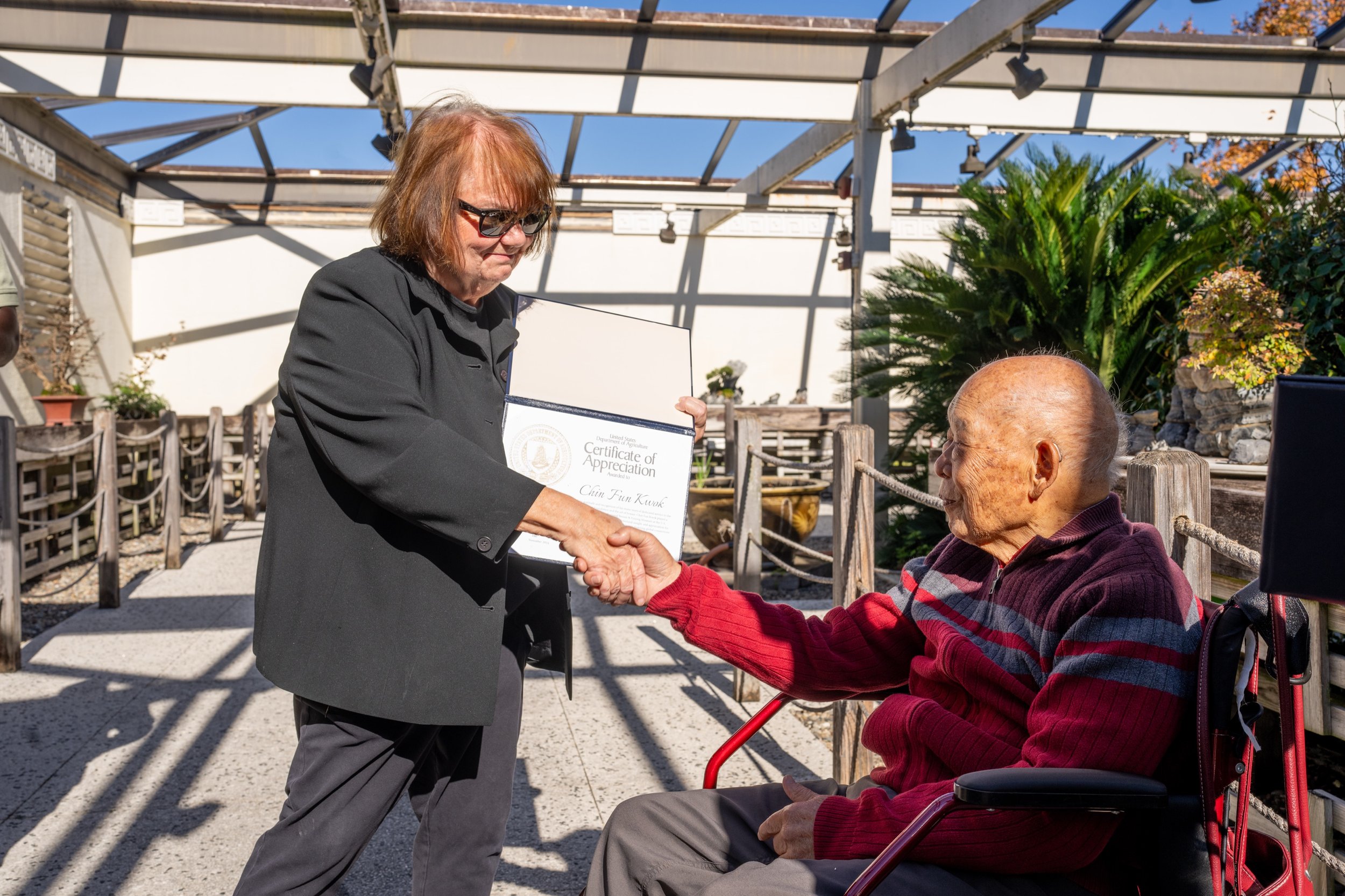We were recently honored by a visit from Seiji Morimae, a renowned figure in the world of bonsai and suiseki. Morimae holds special esteem at both the National Bonsai Foundation and the National Bonsai & Penjing Museum in Washington, D.C., which he has supported for many years.
Curator Michael James welcomes Yaeko and Seiji Morimae to the National Bonsai & Penjing Museum.
As a bonsai expert and board member of the Nippon Suiseki Association, he has made significant contributions to the preservation of Japanese bonsai culture. His deep connection with the museum, particularly as a donor and cultural ambassador, underscores his lasting impact.
Welcoming Seiji and his wife Yaeko for a tour of the National Bonsai & Penjing Museum, we honored his lifelong dedication to bonsai and suiseki while viewing the highlights of America’s renowned national collections. Dr. Richard Olsen, director of the U.S. National Arboretum – along with museum curator Michael James, and National Bonsai Foundation executive director Bobbie Alexander – were on hand to officially welcome the Morimaes. Jack Sustic, Chair Emeritus of the National Bonsai Foundation and Vice-Chair of the World Bonsai Friendship Federation, also joined the group in the welcome. Peter Warren, an international bonsai professional – one of the few who has completed a full six-year apprenticeship in Japan under legendary expert Kunio Kobayashi – accompanied the Morimaes and served as translator.
Among the highlights at the Museum is Morimae’s gift of a “hut stone” suiseki, displayed in the traditional tokonoma setting – a tribute to his commitment to preserving and sharing Japanese culture. He has also donated several first-class bonsai over the years. In the North American Pavilion, Michael discussed how American bonsai has evolved, inspired by influential leaders like Morimae. Dr. Olsen concluded with remarks on the museum’s role in advancing the art of bonsai in America, celebrating Morimae’s impact and support. The event ended with refreshments and reflections on his exceptional contributions to these timeless art forms.
credit: valavanisbonsaiblog.com
Morimae's journey into bonsai began more than 50 years ago with a dedication to the art of formal display, also known as keido. He has learned from and studied with revered bonsai artists, including Susumu Sudo, Jiro Fukuda, and Masahiko Kimura, who shaped his approach and artistry. His life has been deeply intertwined with the practice and philosophy behind these forms, and over the years, he has established multiple bonsai and suiseki businesses, including the prestigious Kyoto Bonsai Garden at the Daitoku-ji Temple in Kyoto, Japan.
His connection to the National Bonsai & Penjing Museum has spanned many years, where he has donated both bonsai trees and suiseki stones, helping to enhance the museum’s nationally renowned collections. He has visited the United States numerous times over the past 20 years to share his expertise on the arts of bonsai and suiseki.
credit: valavanisbonsaiblog.com
In 2017, during the renovation and rededication of the museum’s Japanese Pavilion, Morimae delivered a speech expressing his gratitude for the museum’s role in preserving bonsai trees gifted to the United States. He shared that these living symbols of friendship between Japan and America are more than just plants—they are a carrier of our stories, a marker of our time, and a reminder of nature’s elegant resilience.
“This is the magnificence of life,” Morimae said. “I believe that bonsai can teach us about our own lives. Each of them tells its own humble story, woven of nature, human history, and time itself.”
Seiji Morimae’s presence at the museum is not just symbolic; it speaks to his deep sense of responsibility. As a figure of great respect in the bonsai community, he often plays the role of a "big brother," checking on the museum’s Japanese bonsai collection, much like the revered Saburo Kato before him. This support has helped the museum maintain a high standard of care and presentation, ensuring the continued vitality of its bonsai and suiseki displays.
Morimae’s dedication to bonsai has also been captured in various media, including the U.S. National Arboretum’s Bicentennial Bonsai film. His passion for bonsai and suiseki extends beyond physical preservation; it is about sharing a philosophy of life that bonsai can teach us—about resilience, growth, and the delicate balance between nature and humanity.
Seiji Morimae at the National Bonsai & Penjing Museum in 2024.

































